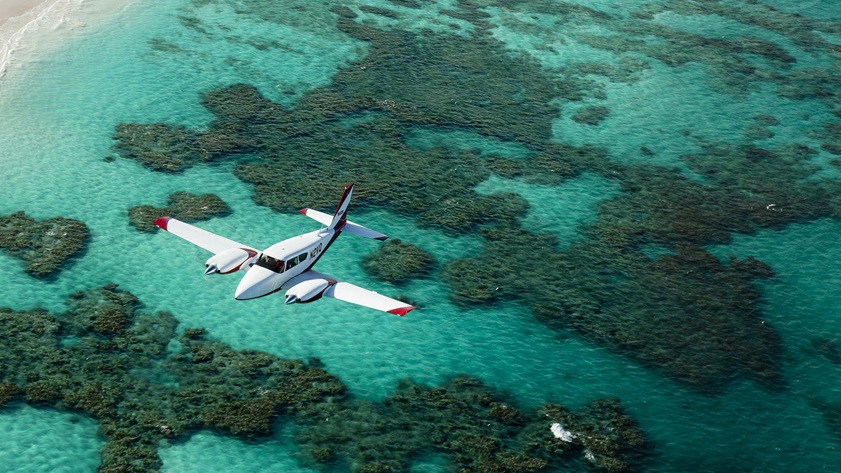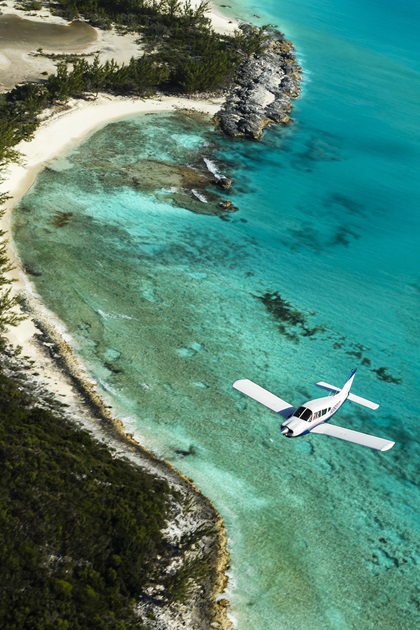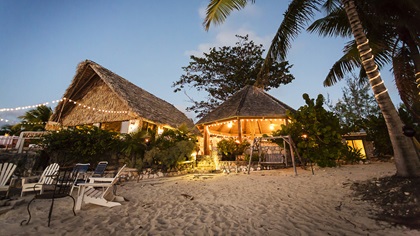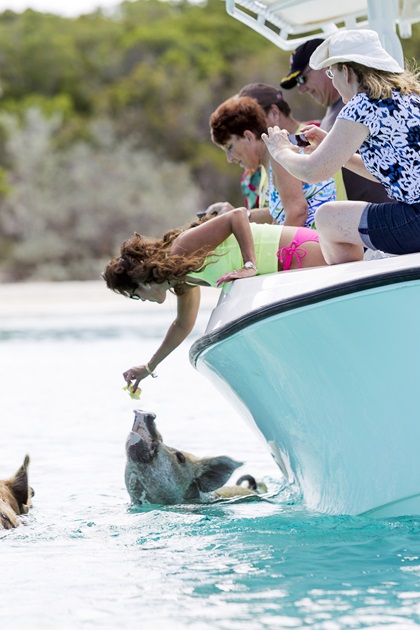"Anybody want to go to the Bahamas?"
As the Piper Twin Comanche accelerates down the runway at Manassas Regional Airport, the pilot’s remark is part joke, part rally cry. It’s time to leave this wretched Northeast winter behind. The promise of sunshine and cerulean waters awaits pilots and passengers who are participating in a group fly-out—but the trip itself will provide as many learning opportunities as any pilot could hope to experience.

“Even the more experienced pilots wouldn’t do this if there wasn’t somebody to push them out of the nest,” says Bob Hepp, owner of Aviation Adventures, a flight school based in Manassas. This is the third year that Aviation Adventures has organized a fly-out to the Bahamas. The flight school frequently hosts these junkets, which range from a one-day trip to fly the Hudson River corridor in New York to a several-day jaunt to EAA AirVenture in Oshkosh, Wisconsin. Such trips can help pilots build cross-country time, or simply show them that flying is fun. In the case of the Bahamas trip, it’s also to encourage pilots to get more out of their flying, Hepp says.
“Once they do it, they realize it’s not as intimidating” as they had thought, Hepp says. This year, 12 airplanes are along for the adventure, including a Diamond DA42, a Cessna 206, two Cessna 182s, two 172s, a Piper Arrow, a Beechcraft Bonanza, and a Tecnam Sierra Light Sport aircraft. Hepp and his wife, Ronnie, are flying the Twin Comanche.
The group will overnight in Fort Pierce, Florida, before launching for the final leg to New Bight Airport on Cat Island, about 327 nautical miles away. Aviation Adventures hosts the flyout but does not provide any type of concierge services—the pilots handle their own paperwork, make their own hotel reservations, and the like.
This trip involves crossing international borders and flying over water, so the pilots have attended four planning meetings, going over in exhaustive detail the equipment needed for the aircraft and passengers; FAA and Customs and Border Protection requirements; and of course the CPB’s Electronic Advance Passenger Information System (eAPIS), the web-based application that collects information on private aircraft departing or arriving the United States to or from a foreign location (see “What You’ll Need,” left). Some in the group are first-timers. Nobody wants to miss a single detail—not even Larry and Ruth Sooby, former Virginia residents who now live in Wichita, Kansas. They have been participating in the planning sessions via Skype.
Getting there—half the fun?
Most of the airplanes are wheels up from Virginia on January 31. Temperatures are in the teens, and patches of snow can be seen on the ground well into North Carolina. Hepp has been checking in with other Aviation Adventures airplanes on the air-to-air frequency. It’s a friendly exchange that combines information sharing, moral support, and camaraderie. The pilots compare notes on ground speed at various altitudes; for now, the weather is severe clear with only a bothersome headwind that is stronger at higher altitudes.
Five aircraft rendezvous at Lowcountry Regional Airport in Walterboro, South Carolina, for fuel and a barbecue lunch. Unfortunately, the VFR conditions are eroding farther south. This isn’t an issue for the instrument-rated pilots, but three others are traveling VFR. And one of those VFR pilots is fairly wet behind the ears. Arnaud Van Der Haegen earned his private pilot certificate in August and hasn’t yet logged 100 hours.
For a time, the Twin Comanche is the lead goose in the flock, slightly ahead of the Diamond DA42, the Piper Arrow, and the two 172s. Van Der Haegen asks for pireps; he is flying above clouds and doesn’t want to get stuck on top. Hepp passes along cloud coverage reports and suggests that Van Der Haegen head farther inland, where the skies are clearer.
At about 4 p.m., the Twin Comanche touches down at Fort Pierce, and Hepp takes attendance. That swath of IMC en route meant all three VFR pilots had to land well short of their destination. They are scattered up the coast: Fernandina Beach; Savannah, Georgia; St. Simons, Georgia. A fourth instrument-rated pilot flying a Cessna 182 experienced radio problems when she tried to depart her fuel stop, and has returned to Savannah to troubleshoot. And a fifth pilot is still in Virginia because his wife has been ill.
The remaining members of the group gather that night at a Fort Pierce Red Lobster for a final planning dinner. Hepp circulates among the tables. “I’m on a mission,” he announces. He can’t rescue the pilot with the ailing radio, or the pilot in the Tecnam, which isn’t certified for instrument flight (see “Florida Keys Consolation Prize,” above). But there is help for the others. Troy Marshall, owner of a six-seat Bonanza, will carry instrument-rated pilots to a stranded Cessna 172 in Fernandina Beach and a Cessna 206 in Savannah. They will be pilots in command to get the airplanes to Fort Pierce. Marshall is training for the instrument rating, and he is traveling with CFII Roger Coffman so that he can log some real-world IFR. He gets it in spades: Rising before dawn the next day, Marshall and Coffman execute an approach to minimums at Fernandina Beach. The mission goes as planned. The pilots scramble to file their eAPIS manifests before departing for the Bahamas that afternoon. All this, and the international portion of the trip hasn’t even begun.
The brilliant blue
 Engine failure over open water is a very real concern on a trip like this, which is why everyone is required to have a life vest, and some in the group have rented or purchased life rafts. Those concerns fade as the airplanes climb out over the Atlantic and the greenish waters of coastal Florida change to the unmistakable teal and turquoise hues of the Caribbean.
Engine failure over open water is a very real concern on a trip like this, which is why everyone is required to have a life vest, and some in the group have rented or purchased life rafts. Those concerns fade as the airplanes climb out over the Atlantic and the greenish waters of coastal Florida change to the unmistakable teal and turquoise hues of the Caribbean.
All traffic must be on either an instrument flight plan or a DVFR international flight plan, so the pilots are in contact not only with each other but also with Miami Center, then Nassau Center. With Grand Bahama Island just 106 nm from Fort Pierce, the island appears on the horizon in a short time. From that point, the airplanes are seldom out of gliding distance to one of the many Out Islands that form a chain stretching for miles
Paperwork. As island hopping is on the agenda, each of the pilots has submitted several copies of the Inward Declaration/Cruising Permit, also known as a ferry permit, which will enable them to travel to any other Bahamian airport before they head back to the United States.
Stopping here and there
 With New Bight as the home base, the Aviation Adventures group stays at Fernandez Bay Village, a cluster of European-flavored stone cottages and villas amidst coconut trees and tropical flowers. Its owner, Tony Armbrister, is a passionate private pilot—he flies his Beechcraft Baron to Florida three or four times a month to pick up supplies. Fernandez Bay Village has always catered to pilots, but in the early 1980s the general public became aware of the secluded resort, thanks to a write-up in Travel & Leisure magazine. Still, during this first week of February most of the resort’s guests are private pilots or right-seaters, ecstatic to be in a tropical climate at last.
With New Bight as the home base, the Aviation Adventures group stays at Fernandez Bay Village, a cluster of European-flavored stone cottages and villas amidst coconut trees and tropical flowers. Its owner, Tony Armbrister, is a passionate private pilot—he flies his Beechcraft Baron to Florida three or four times a month to pick up supplies. Fernandez Bay Village has always catered to pilots, but in the early 1980s the general public became aware of the secluded resort, thanks to a write-up in Travel & Leisure magazine. Still, during this first week of February most of the resort’s guests are private pilots or right-seaters, ecstatic to be in a tropical climate at last.
Although Fernandez Bay Village guests are encouraged to practice the art of relaxation, only a day passes before the pilots assemble for their first island-hopping expedition. Five Aviation Adventures Airplanes depart New Bight Airport, accompanied by a sixth—an RV–10 flown by Bill and Alicia Watson from North Carolina, who are island hopping on their own. “This place is perfect for pilots,” Bill Watson says of the Bahamas.
Today’s destination is Staniel Cay, part of the string of islands known as the Exumas, for a day of boating, snorkeling, and swimming pigs. Yes, you read that correctly. Swimming pigs—feral porkers that live on an uninhabited cay off the mainland. And swim they do—right up to your boat, so that you can feed them; the Staniel Cay Yacht Club will even provide you with scraps. After that, it’s snorkeling at the Thunderball Grotto—so named because the diving sequence from the James Bond film Thunderball was filmed here. The inside is teeming with tropical fish.
 Even though it has no Customs or fuel service, Staniel Cay is the third busiest airport in the Bahamas, according to Martha Wohlford. She has arrived in a golf cart to ferry the group to the dock, where her family offers boat, golf cart, and vacation rentals. “During March and April, you won’t find a tiedown place,” she says. “It’ll be spilling over.”
Even though it has no Customs or fuel service, Staniel Cay is the third busiest airport in the Bahamas, according to Martha Wohlford. She has arrived in a golf cart to ferry the group to the dock, where her family offers boat, golf cart, and vacation rentals. “During March and April, you won’t find a tiedown place,” she says. “It’ll be spilling over.”
A quick flight from Staniel to Grand Exuma is a necessity so that the pilots can purchase 100LL. Not all airports in the Bahamas sell aviation fuel, and it’s important to check availability when making flight plans. In fact, even an airport that is reported to have fuel may not have any, so a call in advance is a good idea.
Where Columbus walked
It’s tough to top swimming pigs, but the group’s second flyout, to San Salvador just about 54 nm southeast of New Bight, is a history lover’s dream. Six airplanes touch down on the 8,000-foot runway to visit the site where Columbus is said to have landed in search of the new world. A gleaming white stone cross marks the location, along with a massive sculpture that denotes the spot where the Olympic torch began its journey to Mexico City for the 1968 Summer Olympics.
The extra-long runway seems an anachronism until an Airbus A330 arrives bringing some 200 passengers, many of whom are headed to Club Med. San Salvador’s waters are known for great scuba diving, but none of the Aviation Adventures group will be diving today so as not to expose themselves to decompression sickness. As before, the group ends the afternoon with a quick trip to Stella Maris Airport on Long Island for fuel.
All too quickly, it’s time for the sun-soaked Aviation Adventurers to file their return eAPIS manifests and collect their belongings, travel documents, and cash in preparation for departure (see “Don’t Forget Your Wallet,” above). Snow, ice, and sleet are in everyone’s forecast back in Virginia and Kansas. For this week, however, there’s been nothing but sunshine tempered with the realization that only general aviation could make a trip like this a possibility—let alone a reality.
Reflecting on the trip, Van Der Haegen says he gained a lot of real-world flying experience, and he felt comfortable being surrounded by a group of more experienced pilots. “I firmly believe such a trip made me a better pilot.”



